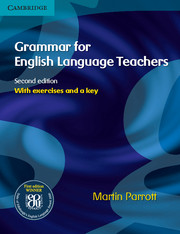20 - Sentence constituents: basic principles
Published online by Cambridge University Press: 09 February 2023
Summary
Key considerations
In this chapter we look at sentence constituents, the basic units such as noun phrases, verb phrases and preposition phrases that make up meaningful language. We look at the kinds of words we choose and combine in order to form these basic constituents, and the order in which we use them. We also look at the different functions these basic constituents play in sentences (e.g. subject, object, complement and adverbial).
The terms that grammars use for classifying sentence constituents vary from grammar to grammar, and the descriptions are often very complicated and technical. For fear of confusing learners, teachers may choose to avoid giving technical explanations and analysis, and we may teach these features more in response to specific problems that arise than according to any predetermined syllabus. Although we don’t need to remember the technical terms for describing basic constituents, we need to know and understand how these constituents are formed and how they fit together.
When we look at real language we find that many sentences contain forms other than those we look at in this chapter. Chapters 21 and 22 deal with a number of ways in which we modify the basic principles, and Chapters 25–30 look at different kinds of subordinate clauses, which often involve some further variation on these.
What are sentence constituents?
A sentence can be seen as a string of ‘units’ or blocks of language in a certain order. These units, or ‘sentence constituents’, consist of words or phrases. To change the meaning, we can change the words or phrases in each constituent. The order, however, remains the same. This useful but over-simplified model is sometimes called a ‘slot and filler’ view of language.
We have to consider sentence constituents from two perspectives:
• what they are in terms of the words that make them up.
• the function they perform in sentences.
A constituent may look exactly the same even though it appears in different positions in the sentence and, therefore, performs a different grammatical function.
The term ‘phrase’ is used for different types of constituent even though, somewhat confusingly, these ‘phrases’ may consist of only one word.
- Type
- Chapter
- Information
- Grammar for English Language Teachers , pp. 292 - 314Publisher: Cambridge University PressPrint publication year: 2010



